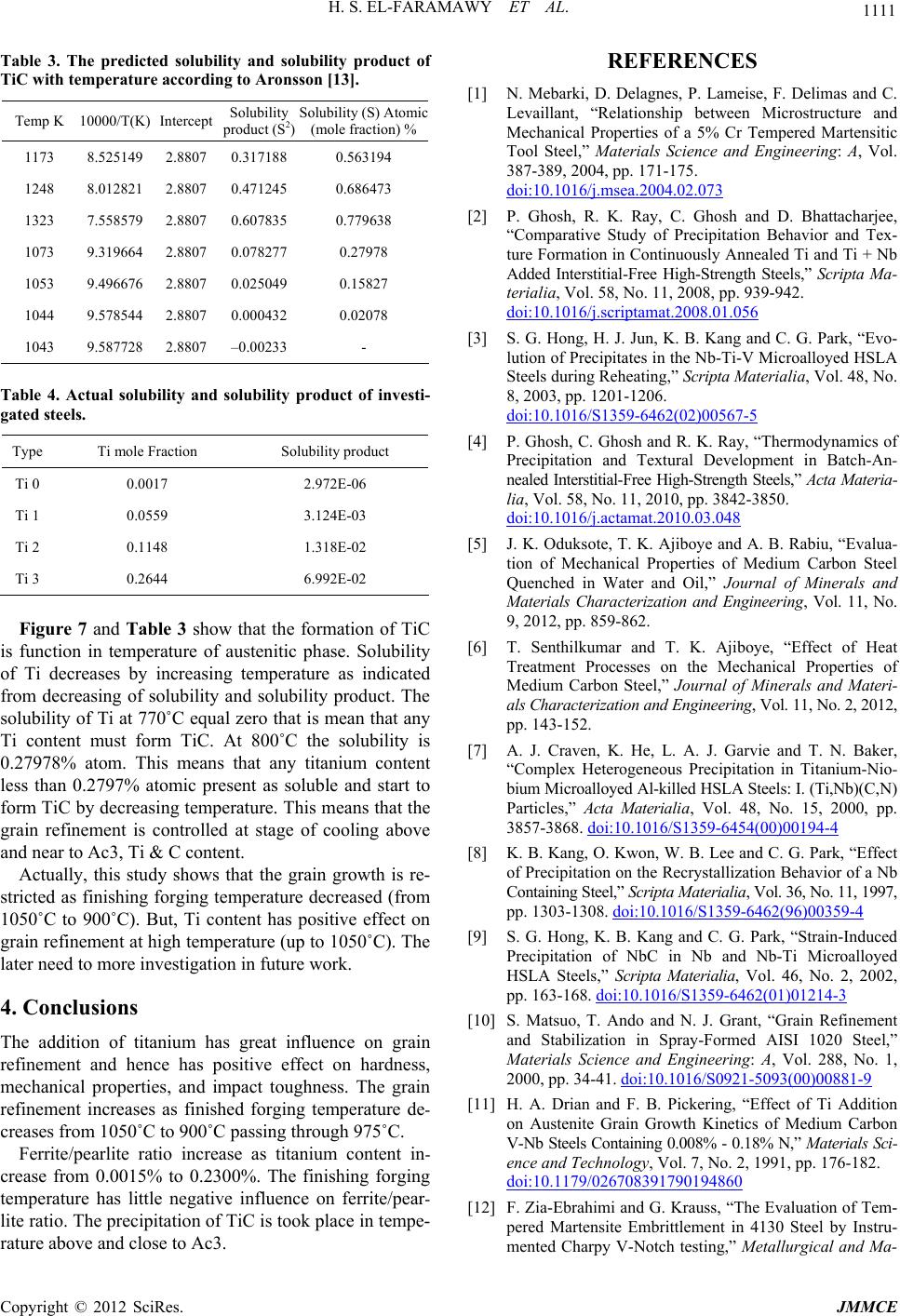
H. S. EL-FARAMAWY ET AL. 1111
Table 3. The predicted solubility and solubility product of
Temp K 10000/T(K) Intercept mic
TiC with temperature according to Aronsson [13].
Solubility Solubility (S) Ato
product (S2) (mole fraction) %
1173 8.525149 2.8807 0.317188 0.563194
1248 8.012821 2.8807 0.471245 0.686473
1323 7.558579 2.8807 0.607835 0.779638
1073 9.319664 2.8807 0.078277 0.27978
1053 9.496676 2.8807 0.025049 0.15827
1044 9.578544 2.8807 0.000432 0.02078
1043 9.587728 2.8807 –0.00233 -
able 4. Actual solubility and solubility product of investi-
Type Ti mole Fraction Solubility product
T
gated steels.
Ti 0 0.0017 2.972E-06
Ti 1 0.0559 3.124E-03
Ti 2 0.1148 1.318E-02
Ti 3 0.2644 6.992E-02
Figure 7 and Table 3 show that the formation of TiC
is
the grain growth is re-
st
4. Conclusions
nium has great influence on grain
cr
[1] N. Mebarki, D. Delagnes, P. Lameise, F. Delimas and C.
Levaillant, “Ricrostructure and
Mechanical Prpered Martensitic
function in temperature of austenitic phase. Solubility
of Ti decreases by increasing temperature as indicated
from decreasing of solubility and solubility product. The
solubility of Ti at 770˚C equal zero that is mean that any
Ti content must form TiC. At 800˚C the solubility is
0.27978% atom. This means that any titanium content
less than 0.2797% atomic present as soluble and start to
form TiC by decreasing temperature. This means that the
grain refinement is controlled at stage of cooling above
and near to Ac3, Ti & C content.
Actually, this study shows that
ricted as finishing forging temperature decreased (from
1050˚C to 900˚C). But, Ti content has positive effect on
grain refinement at high temperature (up to 1050˚C). The
later need to more investigation in future work.
The addition of tita
refinement and hence has positive effect on hardness,
mechanical properties, and impact toughness. The grain
refinement increases as finished forging temperature de-
creases fro m 1050˚C to 900˚C passing through 975˚C.
Ferrite/pearlite ratio increase as titanium content in-
ease from 0.0015% to 0.2300%. The finishing forging
temperature has little negative influence on ferrite/pear-
lite ratio. The precipitation of TiC is took place in tempe-
rature above an d close to Ac3.
REFERENCES
elationship between M
operties of a 5% Cr Tem
Tool Steel,” Materials Science and Engineering: A, Vol.
387-389, 2004, pp. 171-175.
doi:10.1016/j.msea.2004.02.073
[2] P. Ghosh, R. K. Ray, C. Ghosh and D. Bhattacharjee,
“Comparative Study of Precipita
ture Formation in Continuously Annealed
tion Behavior and Tex-
Ti and Ti + Nb
Added Interstitial-Free High-Strength Steels,” Scripta Ma-
terialia, Vol. 58, No. 11, 2008, pp. 939-942.
doi:10.1016/j.scriptamat.2008.01.056
[3] S. G. Hong, H. J. Jun, K. B. Kang and C. G. Park, “Evo-
lution of Precipitates in the Nb-Ti-V Microallo
Steels during Reheating,” Sc ripta Mateyed HSLA
rialia, Vol. 48, No.
8, 2003, pp. 1201-1206.
doi:10.1016/S1359-6462(02)00567-5
[4] P. Ghosh, C. Ghosh and R. K. Ray, “Thermodynamics of
Precipitation and Textural Developm
nealed Interstitial-Free High-Strength Stent in Batch-An-
eels,” Acta Materi a-
lia, Vol. 58, No. 11, 2010, pp. 3842-3850.
doi:10.1016/j.actamat.2010.03.048
[5] J. K. Oduksote, T. K. Ajiboye and A. B. Rabiu, “Evalua-
tion of Mechanical Properties of Medium
Quenched in Water and Oil,” Jou Carbon Steel
rnal of Minerals and
” Journal of Minerals and Materi-
oyed Al-killed HSLA Steels: I. (Ti,Nb)(C , N)
Materials Characterization and Engineering, Vol. 11, No.
9, 2012, pp. 859-862.
[6] T. Senthilkumar and T. K. Ajiboye, “Effect of Heat
Treatment Processes on the Mechanical Properties of
Medium Carbon Steel,
als Characterization and Engi neering, Vol. 11, No. 2, 2012,
pp. 143-152.
[7] A. J. Craven, K. He, L. A. J. Garvie and T. N. Baker,
“Complex Heterogeneous Precipitation in Titanium-Nio-
bium Microall
Particles,” Acta Materialia, Vol. 48, No. 15, 2000, pp.
3857-3868. doi:10.1016/S1359-6454(00)00194-4
[8] K. B. Kang, O. Kwon, W. B. Lee and C. G. Park, “Effect
of Precipitation on the Recrystallization Behavior of a Nb
Containi ng Steel,” Scripta Materialia, Vol. 36, No. 11, 1997,
pp. 1303-1308. doi:10.1016/S1359-6462(96)00359-4
[9] S. G. Hong, K. B. Kang and C. G. Park, “Strain-Induced
Precipitation of NbC in Nb and Nb-Ti Microalloyed
HSLA Steels,” Scripta Materialia, Vol. 46, No. 2, 2002,
pp. 163-168. doi:10.1016/S1359-6462(01)01214-3
[10] S. Matsuo, T. Ando and N. J. Grant, “Grain Refinement
and Stabilization in Spray-Formed AISI 1020 Steel,”
Materials Science and Engineering: A, Vol. 288, No. 1,
2000, pp. 34-41. doi:10.1016/S0921-5093(00)00881-9
[11] H. A. Drian and F. B. Pickering, “Effect of Ti Addition
on Austenite Grain Growth Kinetics of Medium Carbon
V-Nb Steels Containing 0.008% - 0.18% N,” Materi als Sci-
ence and Technology, Vol. 7, No. 2, 1991, pp. 176-182.
doi:10.1179/026708391790194860
[12] F. Zia-Ebrahimi and G. Krauss, “The Evaluation of Tem-
pered Martensite Embrittlement in 4130 Steel by Instru-
mented Charpy V-Notch testing,” M
etallurgical and Ma-
Copyright © 2012 SciRes. JMMCE